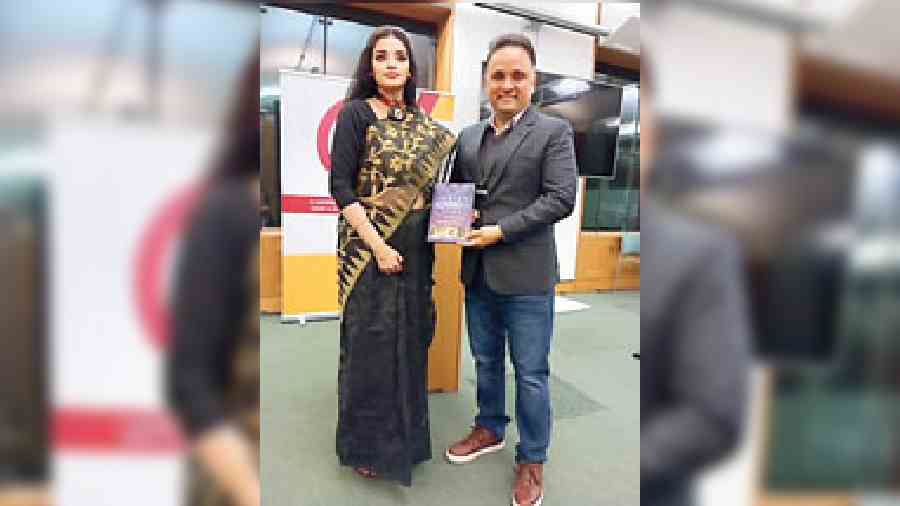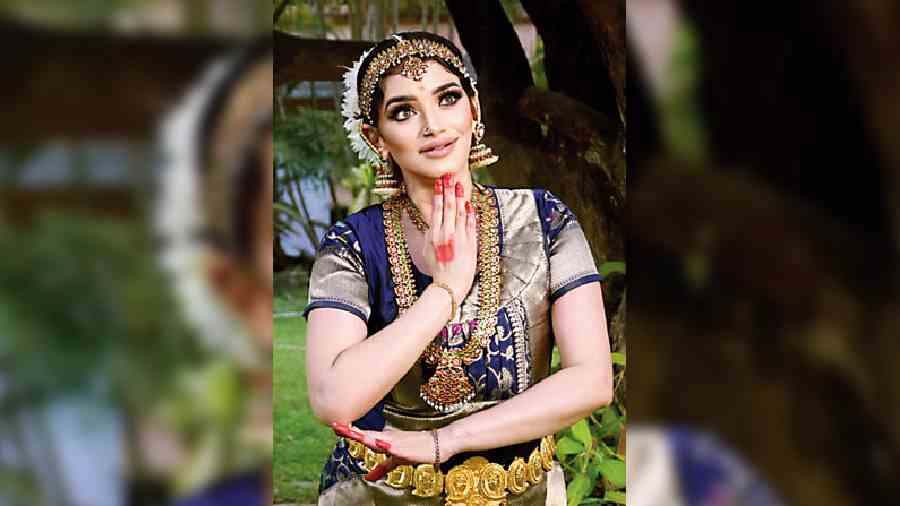Bharatanatyam exponent Sohini Roychowdhury is back with her new book Indian Stage Stories that talks about the ‘deep connection of our Natyashastra with Aristotle’s theories of dramatic unity... about the world being one... without frontiers’. She further decoded the intent of writing this book and what 2023 has in store for her.
Congratulations on Indian Stage Stories. Your prologue is bold. Was this book born out of any particular moment of frustration or years of agony at seeing ‘India-idiotica’ as you describe it?
Thanks so much, and you hit the nail on the head. Years in Spain, I had wonderful students who are performing now and are in love with Bharatanatyam and India, but we had our battles with ‘India-idiotica’ and cultural racism that tried to give our classical arts ‘an exotic festive tribal’ status that was unacceptable to me. So it was our mission and revolution to create awareness of the depth and evolution of our Vedas, our Markandeya Puranas, our Upanishads, our sacred philosophy and its inclusivity and humanism. That India could not be defined by poverty porn or by a smattering of bindis and Bollywood songs, or by doped stupor with pretence spirituality to shirk discipline and hard work. The spirituality of our scriptures is about karma yoga and not hippiedom. That’s what I needed to shout out and that at the very core is Vasudhaiva Kutumbakam, ‘The World is One’.
Tell us about the research process…
The research process is ongoing, even in my dreams! When I teach my students any piece in Bharatanatyam, we have storytelling sessions to explain Krishna’s antics and its deep philosophy or Ma Saraswati’s pristine white light that symbolises education and its powers of purification, Lord Murugan and his significance, the concept of Ardhanareeswar, the ultimate feminist as against the racist theory of ‘Asian battered women!’And, how we transfer that knowledge to the various age groups and the different sections of people we deal with, ranging from five-year-olds to the scholars of Indology, to the elderly and the uninitiated too. The dance operas that we create, it’s vital for me to have a strong mythological storytelling element and a core mantra and we try to decipher some of our Vedic philosophies through dance and storytelling.
I wake up in the middle of the night thinking about Shikhandi or Ganga, and can’t sleep again till I have some of the answers. And I learn so much while I research and teach my students, whether they are five years old or 55! It’s kind of obsessive and never-ending.

Sohini Roychowdhury with Amish Tripathi at the House of Commons
What did you absolutely want to keep in the book?
‘Connecting civilisations’, the deep and indelible connection of all of us, that we are all one. That is the absolute essence of my book. Our Mother Goddess Durga and her soul sister Ishtar, goddess of war and love. Ishtar is the Akkadian counterpart of the West Semitic goddess Astarte. Just as our Ma Kali has her western counterpart in Santa Sarah or Sara La Kali. Being from Kolkata, where our Ma Kali dances on the chest of Shiva, Shaktism and our brand of it was an absolute must in my book to tell the world this is who we are, as against the misogynistic impression of docile, diminutive women in India living under male domination. Our Markandeya Puranas is the ultimate global treatise of feminism and women empowerment. The world just needs to wake up to that.
I wanted to talk about our Navarasa and how catharsis is a part of a rasa, the Greek muses, Thalia and Melpomene, to be able to relate. Our Rasa ‘Shantam’ has no western counterpart and is born of deep meditation and inner peace that can comfort a raging storm. As Parvati sings Raga Malkauns to calm a grief-stricken Shiva, performing the Tandav at Sati’s self-emolument at Daksha’s yajna. The deep layers, the stories and sacred philosophies that are part of us, even the current crop of Indians need to be aware of.
The book starts with a comparative discussion of Aristotle’s theories of dramatic unity and our own Natyasastra by Bharatmuni and it shows how our worlds are connected like our hearts and our art and humanity is our highest identity.
Why do you think there is such a lack of awareness when, really, we are living in the age of information overload?
It’s a lack of interest, I think, shaded with some misogyny and ‘India-exotica’. That’s rampant in the West and in our country too. I felt very offended and hurt when our Ma Kali or Durga is portrayed as a pop feminist by a filmmaker who is trying hard to get cheap popularity by creating a sensation in very bad taste. That disrespect and stupidity bothers me. They don’t know, they don’t read and are not interested… but would love to delve into our heritage and come out with weird sensational interpretations that have no basis. Here ignorance is bliss, like celebrating Holi in October in Spain and having Holi parties with colour and dances.... So all the information overload won’t help unless one is willing to respect and learn. There are such lovely children’s books on Ramayana and Mahabharata too that adults can read and learn. It doesn’t take much effort, so it’s about ignorance and disrespect and the loud attitude that comes with it.
What do you want the book to convey?
Empathy, empathy and empathy, that we are all one, Vasudhaiva Kutumbakam. The world is home to all of us, regardless of skin colour, education, geography, sexual preference, economical status, religion. We are connected as humanity and if children are taught that, maybe a class on empathy along with maths and English, we will step into a tomorrow of light, without discrimination. My mantra for my dance operas and my Sohinimoksha World Dance and Communications is ‘connecting civilisations’. That’s all there is.

Indian Stage Stories is priced at Rs 995
Last year was super packed. What is 2023 looking like for you?
Yes! I am grateful. The highlight of 2022 was my book Indian Stage Stories published by Shubhi Publications, being launched at House Of Commons, UK Parliament, on November 17 by Saudha Arts and TM Kaysher. Fabian Hamilton, MP and Amish Tripathi were present there. And I wrote the book at St Andrews, sitting by the river, in Scotland, under the summer skies, feeding the seagulls. And I loved the experience. It’s definitely a love story as I was performing almost every day. At the Byre theatre, too, and the Indian consulate in Edinburgh.... We will live in 2023 with concerts, storytelling, travelling to different places and connecting civilisations!
In May and June I will be performing in Germany, Austria and UK and have my UNESCO tour, with the schools and colleges with ‘India’s heritage through dance’. November will be in the UK with ‘She Inspires’ where I am honoured to be an ambassador. Autumn would probably be a bout in the US, all going well, but in 2023 I would like to stay in India longer and perform and teach. My students at Little Big Help would be learning more intensively and performing too.... And of course my book readings.
You’ll be back at the Jaipur Literature Festival…
Yes! Am very excited about that! In India my book will be launched at JLF ’23 on January 22 and that’s the highlight of my life and dance this January. It’s a perfect start to the year...
And you have storytelling through dance lined up at Apeejay Kolkata Literary Festival. Can you tell us what you’ll showcase?
Yes, at the 100th year of Oxford Apeejay Lit fest, I am very excited to be doing a storytelling dance session with children, based on some of the children’s storybooks that have been published recently. It would be storytelling, with movement and mudras and I would make it interactive as the children would be dancing as part of the storytelling, as if they are the characters of the story. It adds spice and zest, dance and maybe gets them to read more and helps children express themselves more without being conscious. This sets them free and creates inclusivity that comes to children naturally.
As a kid, what were your favourite stories to hear?
Mythology! My grandparents would always tell me mythological stories and my maternal grandmother Kamala Devi told me stories of Krishna and Radha and Samudramanthan and various stories of Ramayana and Mahabharata. So before I could read, I knew the stories in minute details, and I knew so many Vedic chants from her...
What are the stories that need to be told right now?
All stories, any stories... just to get the storytelling and reading habit among the children and adults... of our heritage, our mythology, our Puranas, our epics and our fairy tales and folk tales of India and the world, that help travel in our mind, sharpens the imagination of children, who will not need entertainment or gadgets all the time.
